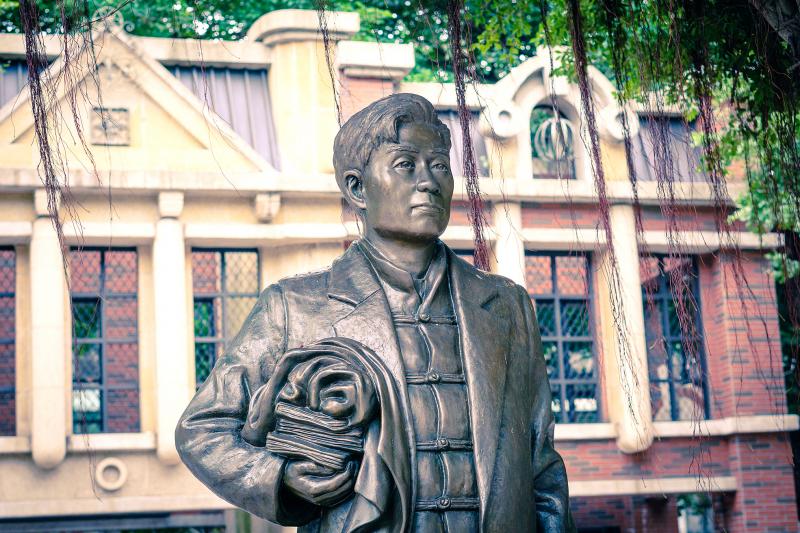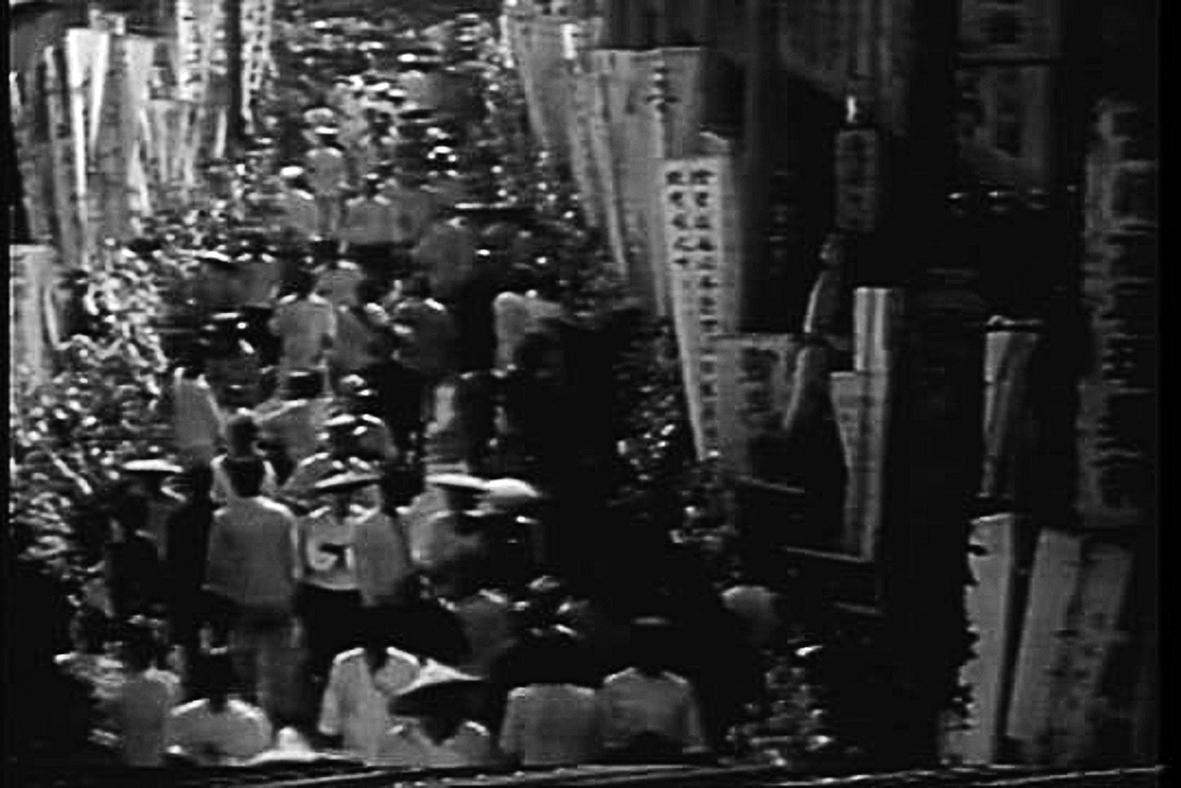Sept.6 to Sept.12
The media dubbed it an “unprecedented funeral” when more than 5,000 mourners flooded the streets of Taipei’s Dadaocheng (大稻埕) to pay their last respects to anti-Japanese democracy activist Chiang Wei-shui (蔣渭水).
The Taihoku (Taipei) Police Department chief watched closely with about 80 plainclothes officers in tow, but the marchers paid them no mind, chanting slogans and waving placards and flags all the way to the cemetery in Yuanshan (圓山). Smaller processions were also held in other cities across Taiwan — long-time frenemy Lin Hsien-tang (林獻堂) organized one in Taichung later that afternoon.

Photo courtesy of Wei-te Wong
The event took place on Aug. 23, 1931, less than three weeks after Chiang died at the age of 40 from typhoid fever. Chiang was a staunch leftist, and his last recorded words reflected his beliefs: “Taiwan’s social revolution is in its third phase, and the victory of the proletariat is imminent. Our young comrades must fight hard, and our old comrades must band together and help our young comrades to liberate our compatriots.”
The colossal procession was given a unique Hoklo (also known as Taiwanese) name: taitsiongtsong (大眾葬), or “funeral for the masses. According to the Chiang Wei-shui Foundation, it symbolized a call to all those who were oppressed in Taiwan.
Photographers and videographers recorded the entire ceremony, and the Taiwan Minpao (台灣民報) newspaper reported that “soon, everyone across Taiwan can get a glimpse of how grand the occasion was.”

Photo courtesy of Wikimedia Commons
However, the colonial government quickly banned the showing of any visual evidence of the event, and the only surviving footage remained hidden in private hands until the Taipei City Government purchased it in 2005.
END OF THE PARTY
Chiang’s death came just six months after the demise of the Taiwan’s People’s Party (台灣民眾黨), and it’s said he fell ill due to over-exertion and stress from the fallout. He had been campaigning for Taiwanese autonomy under Japanese rule for over a decade, with 12 prison stints under his belt.

Photo courtesy of Wikimedia Commons
The Han Taiwanese resistance movement had been fractured for years. In 1927, the Taiwan Cultural Association split into two factions, with Chiang and Lin forming Taiwan’s first political party after several failed attempts. The Japanese reluctantly approved after members promised not to espouse Taiwanese nationalism, and that Chiang would not hold any leadership positions.
The party tackled a number of social issues instead, most notably alerting the League of Nations to the colonial government’s producing and selling of opium to Taiwanese. Although the government refused to give up its lucrative monopoly, the party’s efforts led to the visit of several league officers, causing an international stir.
Chiang and Lin eventually fell out due to Chiang’s increasingly leftist leanings and endeavors. In August 1930, Lin launched the Taiwan Local Autonomy Alliance (台灣地方自治聯盟) with other prominent activists such as Tsai Pei-huo (蔡培火) and Yang Chao-chia (楊肇嘉). The Taiwan’s People Party tried to stop its members from joining the alliance, eventually expelling Tsai and 16 other members, leading Lin to walk away in protest.

Photo courtesy of Wikimedia Commons
This event reportedly hit Chiang hard, but he continued pushing for worker’s rights and caused another uproar by alerting the Japanese diet to the colonial government’s alleged use of chemical weapons during the Wushe Incident (霧社事件), a violent indigenous Seediq uprising against years of Japanese oppression. This led to the downfall of governor-general Eizo Ishizua and three other high-ranking officials.
The new governor-general ordered a mass crackdown on Taiwanese leftist groups in early 1931. In February, police barged into what would become the Taiwan People’s Party’s final meeting and ordered them to shut down.
FINAL JOURNEY
In response, Chiang wrote in Taiwan Minpao that the government’s actions proved that it was afraid of the people’s power. He announced that he wouldn’t be forming any more groups.
“The government is not going to let us form the type of party that we need. A government-approved party is nothing but a hollow shell,” he wrote.
Instead, he argued that party members should use their resources to mobilize peasants and working class, but not everyone agreed and he spent the last few months of his life embroiled in a war of words with his peers through newspaper op-eds.
After Chiang’s death, his followers draped over his body a Taiwan People’s Party flag, which he modeled after the Republic of China flag, with a white sun upon a half-blue, half-red background. Those opposed to Japanese rule in Taiwan often looked toward the “motherland” of China, but Chiang explained the design’s leftist connotations: “Blue is a national movement, red is class struggle and white is the sun, which represents brightness.”
The colonial government did not approve of the flag, so during the ceremony a different one, also of his design, was laid on his casket. The Japanese also prohibited the mourners from reciting Chiang’s last words about social revolution. When the staunchly anti-communist Chinese Nationalist Party (KMT) later erected a monument to Chiang in 1952, they altered the message by replacing “social movement” with “us” and “proletariat” with “Taiwanese.”
The massive procession first visited Chiang’s Da-an Hospital (大安醫院) in today’s Dadaocheng area, where he and Lin embarked on their revolutionary journey by co-founding the Taiwanese Cultural Association in 1921. They then headed to the defunct headquarters of the Taiwan People’s Party to pay their respects before marching to Chiang’s final resting place at today’s Jiantan Mountain (劍潭山).
Lin and Yang did not attend the historic funeral, but held their own memorial on the same day in Taichung with about 70 attendees. Both men, and others Chiang had clashed with, penned emotional eulogies, acknowledging their respect despite their differences.
Taiwan in Time, a column about Taiwan’s history that is published every Sunday, spotlights important or interesting events around the nation that either have anniversaries this week or are tied to current events.

This month the government ordered a one-year block of Xiaohongshu (小紅書) or Rednote, a Chinese social media platform with more than 3 million users in Taiwan. The government pointed to widespread fraud activity on the platform, along with cybersecurity failures. Officials said that they had reached out to the company and asked it to change. However, they received no response. The pro-China parties, the Chinese Nationalist Party (KMT) and Taiwan People’s Party (TPP), immediately swung into action, denouncing the ban as an attack on free speech. This “free speech” claim was then echoed by the People’s Republic of China (PRC),

Exceptions to the rule are sometimes revealing. For a brief few years, there was an emerging ideological split between the Democratic Progressive Party (DPP) and Chinese Nationalist Party (KMT) that appeared to be pushing the DPP in a direction that would be considered more liberal, and the KMT more conservative. In the previous column, “The KMT-DPP’s bureaucrat-led developmental state” (Dec. 11, page 12), we examined how Taiwan’s democratic system developed, and how both the two main parties largely accepted a similar consensus on how Taiwan should be run domestically and did not split along the left-right lines more familiar in

Specialty sandwiches loaded with the contents of an entire charcuterie board, overflowing with sauces, creams and all manner of creative add-ons, is perhaps one of the biggest global food trends of this year. From London to New York, lines form down the block for mortadella, burrata, pistachio and more stuffed between slices of fresh sourdough, rye or focaccia. To try the trend in Taipei, Munchies Mafia is for sure the spot — could this be the best sandwich in town? Carlos from Spain and Sergio from Mexico opened this spot just seven months ago. The two met working in the

Many people in Taiwan first learned about universal basic income (UBI) — the idea that the government should provide regular, no-strings-attached payments to each citizen — in 2019. While seeking the Democratic nomination for the 2020 US presidential election, Andrew Yang, a politician of Taiwanese descent, said that, if elected, he’d institute a UBI of US$1,000 per month to “get the economic boot off of people’s throats, allowing them to lift their heads up, breathe, and get excited for the future.” His campaign petered out, but the concept of UBI hasn’t gone away. Throughout the industrialized world, there are fears that